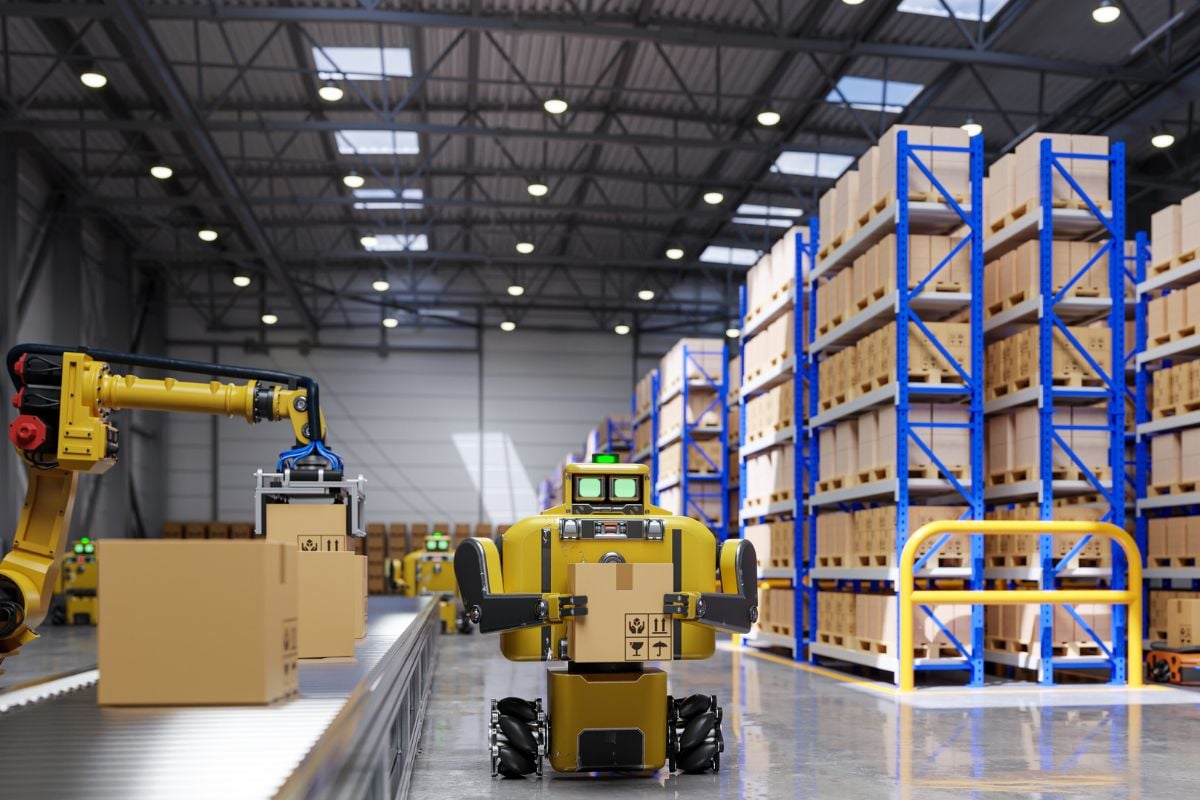Technological advancements continue to revolutionise our personal and professional spheres, with the supply chain being no exception.
Connected devices, robotics, big data, machine learning, and various other technologies are continually shaping the supply chain of tomorrow.
Amid this array of new innovations, artificial intelligence, capable of getting ever closer to human intelligence, is steadily gaining prominence within supply chains. It has already proven its potential to enhance the overall performance of entire industries.
In this article, we will explore how artificial intelligence is already reshaping the supply chain and anticipate upcoming innovations.
Menu:
1 | How does artificial intelligence work?
2 | The impact and benefits of AI for the supply chain
3 | What lies ahead for artificial intelligence and the supply chain of the future?
1. How does artificial intelligence (AI) work?
Artificial intelligence (AI) is a field of computer science focused on developing systems that can mimic specific cognitive functions of humans. AI enables machines to learn, reason, and make decisions akin to human capabilities.
Its operation is based on 2 principles:
-
machine learning using sophisticated algorithms, which allow machines to learn, reason and make decisions.
-
the use of big data, which feeds and improves the knowledge of machines.
Furthermore, various techniques can be integrated with learning algorithms to enhance the effectiveness and dependability of an AI, including:
-
Deep learning, a branch of AI based on artificial neural networks:
Taking inspiration from the human brain, these networks analyse data through consecutive layers to extract intricate and hierarchical features. Deep learning excels in challenging tasks such as image recognition, machine translation, and text generation.
-
Supervised and unsupervised learning techniques:
Supervised learning employs 'labelled' data to instruct machines in predicting future outcomes, using data associated with known correct answers. In contrast, unsupervised learning identifies structures and relationships within data lacking predefined answers.
As you may have gathered, AI encompasses a diverse array of methods and techniques which aim to give machines human cognitive skills, all of which can be integrated into various phases of your supply chain to enhance efficiency.
2. The impacts and benefits of AI for the supply chain
Globally recognised corporations like Amazon and Google have already incorporated artificial intelligence into their supply chains and are witnessing significant impacts from this technology in their supply chain management. Let's assess the current situation.
2.1. Predictive analysis: a strategic asset across multiple levels
The best management and optimisation of supply chain ressources
With advanced AI models, businesses now have access to real-time data for every aspect of their supply chain, enabling them to strategise and forecast future activities while making more informed decisions.
The capacity to forecast demand fluctuations enables companies to fine-tune their inventory levels, preventing costly overstocking or detrimental stock shortages. AI functions as a predictive engine, aiding businesses in maintaining a delicate equilibrium between supply and demand.
Predictive analytics also empowers businesses to devise more efficient logistics routes than ever before.
AI considers multiple factors, including current traffic conditions, regulatory requirements, and customer preferences, to ascertain the most optimal routes for carriers.
This optimisation not only curtails transportation-related supply chain costs but also diminishes its environmental impact by reducing the overall distance travelled.
Example: How did predictive analysis improve Amazon’s reverse logistics?
During the pandemic, the global giant Amazon experienced an astounding surge in orders, which also led to a substantial rise in product returns (+70% between 2019 and 2020).
To manage the costs linked to these returns, Amazon introduced an artificial intelligence-driven solution to evaluate the economic feasibility of each returned product. This AI considers several factors, including the product's size, its initial price, and the costs associated with return shipping, to decide whether the customer should keep or return the item. In either scenario, the customer receives a refund.
Risk reduction through predictive maintenance
Unlike corrective maintenance, which occurs after an incident has occurred, predictive maintenance allows incidents to be anticipated before they occur, which makes it possible to:
-
Minimise service interruptions.
-
Optimise operations and gain productivity.
-
Reduce costs linked to unforeseen breakdowns.
How does it work?
Utilizing AI, sensors continuously analyse and monitor the parameters of a machine or equipment, overseeing its performance and thereby identifying early indications of potential issues.
2.2. AI and technologies "intelligent" warehouse management
Thanks to the integration of AI for process automation, automated handling systems and robots are now coexisting in warehouses, efficiently sorting, storing, and retrieving items with precision.
This automation reduces human errors, speeds up processing times, and consequently enhances the overall performance of the supply chain.
Furthermore, real-time AI tracking offers comprehensive visibility into warehouse operations, empowering managers to make well-informed and strategic decisions for workflow optimisation and resource allocation.
Please note that various other technologies, such as big data, augmented reality, logistics warehouse management software packages, and RFID chips, work in tandem to achieve and operate the technological advancements in smart warehouses. As you may have gathered, AI is brilliant, but currently works best as part of a team!
Example: Engie’s intelligent inventory management by Vekia
The French multinational Engie, specialising in electricity production and management, conducts approximately 14,000 interventions daily for both professionals and individuals.
This substantial volume of interventions is coupled with a vast catalogue of nearly 1 million references stocked across 230 reference agencies, highlighting the critical importance of efficient inventory management to meet field technicians' demands.
To enhance the performance of its services, the company adopted Vekia, a solution that automates and optimises inventory management. Leveraging an algorithm that incorporates Machine Learning techniques, the system analyses data from agencies, calculates stock levels, and generates order proposals for each management point.

3. What lies ahead for AI and the supply chain of the future?
AI presents exciting opportunities for the future of supply chains, featuring a landscape populated by progressively autonomous robots and ongoing innovations aimed at further optimising supply chain operations.
3.1. AI and Blockchain: a promising partnership for enhanced cybersecurity
Safeguarding company data is a critical concern, particularly with the increasing use of AI, which involves the collection and analysis of vast quantities of sensitive information.
Blockchain, a technology designed for secure and decentralised storage and transmission of data, offers the potential to enhance both the transparency and security of data processed by AI.
In essence, each transaction conducted on the blockchain is grouped with others to create a 'block,' and each block is cryptographically linked to the one before it, forming a continuous 'chain' of blocks, hence the name 'blockchain.'
This on-chain structure ensures the integrity and security of data, as any alteration in a prior block necessitates the modification of all subsequent blocks—a highly challenging task to achieve fraudulently.
This transparent, reliable, and secure operation addresses the evolving cybersecurity challenges of tomorrow's supply chains.
3.2. Traceability, a convincing response to the challenges of sustainable development
Current trends indicate that consumers are increasingly concerned about the origin, quality, and environmental impact of the products they purchase. Traceability is therefore evolving into an essential tool to provide them with answers.
Technologies such as blockchain and artificial intelligence are poised to enhance traceability, making it more accurate, reliable, and automated. This represents a significant asset for supply chains that have traditionally relied on the transparency and diligence of interactions among various stakeholders.
By enabling the comprehensive tracking of a product's journey from creation to distribution and by providing precise information about production methods, raw material sources, and manufacturing processes, the strengthening of traceability through emerging technologies empowers companies to offer unparalleled transparency, which in turn reinforces consumer confidence in distributors.
Conclusion
In conclusion, artificial intelligence (AI) plays a fundamental role in the evolution of the supply chain towards a more innovative future. The continued integration of AI and other technologies into the supply chain promises to radically transform the way companies manage their operations, while providing a more transparent and accountable experience for consumers.
This promising technological future heralds a supply chain of tomorrow that is not only more efficient and resilient but also environmentally sustainable.
Our teams are available to assist you and ensure a smooth transition towards making the change. Contact us today!



